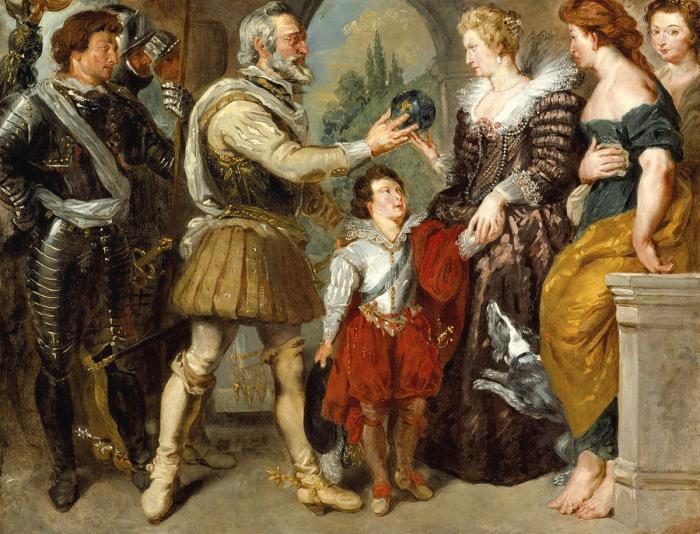Henry iv receives the portrait of marie de medici – In the annals of art and history, the portrait of Marie de Medici, commissioned by her husband, King Henry IV, stands as a testament to their tumultuous relationship and the intricate political landscape of 17th-century France.
This masterpiece, adorned with rich symbolism and exquisite craftsmanship, captures a pivotal moment in their lives, offering a glimpse into the complexities of power, love, and intrigue that defined their era.
Artistic Context

Marie de Medici’s portrait, commissioned by Henry IV in 1600, holds significant artistic and historical importance. The painting is a testament to Henry’s reign and the political and cultural landscape of early 17th century France.
The portrait showcases the artistic style of the Fontainebleau School, known for its opulent and decorative elements. The artist, Frans Pourbus the Younger, employed rich colors, intricate details, and a dynamic composition to depict Marie de Medici as a symbol of wealth and power.
The portrait’s symbolism and iconography are deeply intertwined with the political and cultural context of the time. Marie is portrayed as a powerful and authoritative figure, holding a scepter and orb, symbols of her status as queen. The painting also includes allegorical figures representing virtues such as justice and peace, highlighting the values that Henry IV sought to embody during his reign.
Historical Context
Henry IV, known as Henry of Navarre, was King of France from 1589 to 1610. His reign marked a period of significant political and social change in France.
Henry IV’s marriage to Marie de Medici in 1600 was a strategic move to strengthen his political position and secure the support of the powerful Medici family. The portrait of Marie de Medici was commissioned as a celebration of this union and a symbol of the unity between France and Italy.
The portrait also reflects the cultural changes taking place in France during the Renaissance. The depiction of Marie de Medici as a learned and cultured woman highlights the growing importance of education and the arts in French society.
Technical Analysis: Henry Iv Receives The Portrait Of Marie De Medici

The portrait of Marie de Medici is an oil on canvas painting. Pourbus employed a skillful use of light and shadow to create depth and realism. The painting’s composition is carefully balanced, with Marie de Medici positioned as the central figure and surrounded by allegorical figures.
The color palette is rich and vibrant, with warm colors such as red and gold dominating the foreground. The use of chiaroscuro, the contrast between light and dark areas, creates a sense of drama and intensity.
The brushwork is precise and detailed, capturing the textures and nuances of Marie de Medici’s clothing and accessories. The painting’s overall effect is one of opulence and grandeur, befitting the status of the queen and the occasion it commemorates.
Cultural Impact

The portrait of Marie de Medici had a profound impact on French culture and society. The painting became a symbol of the monarchy and the French nation.
The portrait’s depiction of Marie de Medici as a powerful and cultured woman reflected the changing values and aspirations of French society. The painting also inspired subsequent works of art and historical narratives, contributing to the rich cultural legacy of France.
Today, the portrait of Marie de Medici remains a cherished masterpiece, admired for its artistic beauty and historical significance. It continues to be a testament to the artistic and cultural achievements of Henry IV’s reign and a reminder of the important role that Marie de Medici played in French history.
Frequently Asked Questions
Who was Marie de Medici?
Marie de Medici was an Italian noblewoman who became Queen of France through her marriage to Henry IV in 1600.
Why did Henry IV commission the portrait?
Henry IV commissioned the portrait as a gift for Marie de Medici, to commemorate their marriage and strengthen their political alliance with the Medici family.
What is the significance of the portrait’s symbolism?
The portrait is rich in symbolism, depicting Marie de Medici as a powerful and virtuous ruler, surrounded by allegorical figures representing her virtues and the strength of the French monarchy.